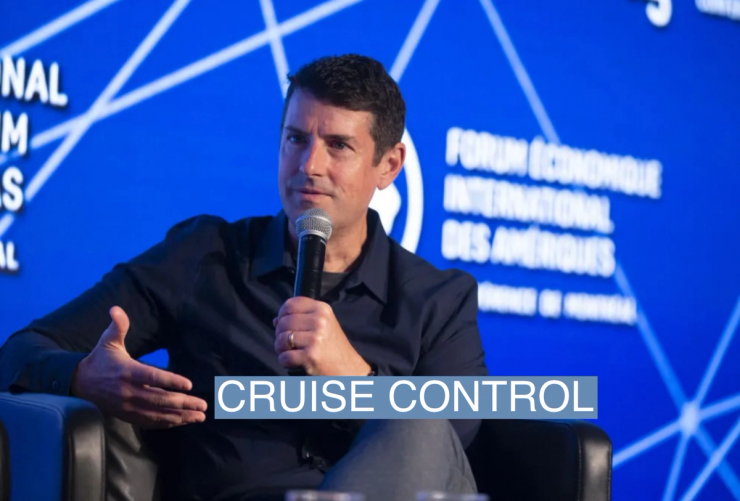The Scene
After years of hype, investor Jon McNeill says the commercialization of autonomous driving is finally upon us. As ex-president of global sales at Tesla, former chief operating officer at Lyft, and now a board member at General Motors, he has been at the forefront of changes in the automotive industry for almost 10 years. In an edited conversation, the CEO of DVx Ventures talks about artificial intelligence in cars, how consumers can make money off of robotaxis, and who could acquire Lyft.
The View From Jon McNeill
Q: A huge shift is happening around AI and large language models that have reached consumers. You’re working on companies in all these different areas. Are you starting to see where this is going to have the biggest impact?
A: We’re on the precipice of having a really cool experience with our cars. My EV should know when I leave every day, and it should precondition the battery for that.
It should know my daily order at my coffee place and put that order in. And tell me if I need a charge and here’s where we’re going. It’s not even AI. It’s just machine learning pattern recognition.
But it doesn’t exist on a Tesla, it doesn’t exist on a GM yet. On the step towards that, when I got on the GM board, one of the things I was curious about was how [self-driving unit] Cruise managed to solve the autonomy problem ahead of massive companies, like Google and Waymo, ahead of Tesla.
When I met [Cruise CEO] Kyle [Vogt], I asked, what’s your secret hack? And he said, we’re roboticists so we operate in ML [machine learning].
And we decided that we could apply ML techniques to this versus AI versus neural nets. Because bringing neural nets to the autonomy problem was like bringing a nuclear bomb to a knife fight.
It was just way too much power. He decided to take a simple approach, and in doing so, solved the problem faster. Ironically, everybody that took the complex path is way behind us.
Q: They had to eventually go back to that approach, right?
A: Tesla still isn’t back to that approach. We are on our way to feeling the real impact of AI. But there are ML steps before that, which are also going to have an impact.
Q: When autonomous driving was the hot thing, a lot of people were saying nobody is going to own a car anymore so what are the big automakers going to do?
Now GM has Cruise, and it’s going to start deploying in all these cities. But it seems like it’s going to be a long time before these cars can completely drive themselves. So people are still going to have to own cars. Did GM get lucky with this technology?
A: They take this approach both with Cruise, the autonomous company, and with Super Cruise, their product in cars.
Super Cruise is hands free and well beyond the other systems that are out there. When they deployed in Austin, it took them a couple of weeks for their models to learn Austin. And they’re adding tens of cities now.
We are on the precipice of this finally rolling out. The two that are way out in front are Cruise and Waymo.
What’s interesting for car manufacturers is this really changes the economic model. I’ll sell a car to a consumer once every five to seven years and make a certain margin to, gosh, this car could make me $250,000 a year.
Q: Is that the eventual result? GM cars will have the Cruise technology, and you’ll rent it out as a robotaxi?
A: We’ll probably have both for a while, but then I think you’ll see this shift. Individuals will have the choice of either having their own autonomous cars in the driveway or as you just said, renting them out to the fleet. It’s amazing how fast these transitions take place.
Q: How much of a headstart do Cruise and Waymo have? Could another company say, we know what to do now? We can just do it faster and we won’t make any missteps.
A: It’s still such a difficult technical problem to solve. What’s interesting for us at DVx is what are the businesses that get spawned off of this? And one of them started to become pretty obvious. If you take a city like San Francisco, there’s one gas station in the city limits. There are no service stations left and a few car repair garages.
So how do you service these fleets of autonomous vehicles? You don’t want to move them out of the city because they will lose their charge on the way in and out. But if somebody spills a latte in the backseat, how do you get that cleaned up?
So we took a twist on a business that we had started at Tesla, which is we discovered that you could fix 80% of what needed to be fixed on a car outside of a service center. That means you can do it anywhere, in a driveway, a parking lot. So we launched Curbee, where we are doing mobile automotive service for consumers and fleets.

Q: You went to Lyft after Tesla. They’re struggling now. So is Lyft valuable to a company like GM as a brand if they want to turn those into robotaxis?
A: Here’s the tough part for Lyft. The economics really don’t point to that answer. It costs Lyft and Uber more than $1,000 to acquire a driver. And it costs Lyft and Uber less than $5 to acquire a consumer. If I’m starting a robotaxi business, I’ve got no driver costs.
But I can go recruit my own consumer base for less than $5 each. And when you add 600,000 roughly monthly riders on Lyft and multiply that by $5, you wouldn’t have to pay very much for a company to acquire those users yourself instead of paying $2 to $3 billion to acquire Lyft. So the economics don’t work.
These networks are worth a lot less to people who have robotaxis. The more important near-term issue is supply constraints. They don’t need to generate much demand to fill up their rides. Over time, they’ll be able to attract consumers to their own platform. That’s tough news for Lyft.
Q: Is anybody a good acquirer?
A: Uber has combined these different businesses of food delivery, rideshare, and package delivery. They’ve got a means to fill a driver’s entire day. And all those businesses provide a really low cost consumer acquisition for each other.
What could be interesting is a combination of DoorDash and Lyft because they would lower each other’s driver acquisition costs and consumer acquisition costs. But DoorDash hasn’t shown an appetite to take on the mess that is Lyft.
Q: So how many companies are you working on?
A: We’ve launched seven. That’s over about two years and we’ve got three more about to launch or in launch phase. Just today, I’m starting on another one that’s EV related. This is a big idea and problem that hasn’t yet been solved in EVs. But it’s still in stealth mode so I can’t talk about it yet.
Q: If you had to pick just one company to start today, what would you do?
A: It is this EV business that we’re working on. When a market reaches 5% of new car sales that are EVs — and we now have dozens of markets to prove this math — that market will go to 40% of cars sold are EVs within four to five years.
We’ve now passed 5% in the U.S. We’re behind the rest of the world. Europe is way in front of us. China is way in front of us.
So if you know how the math is going to play out, we’re at the beginning of the super cycle. In 2025, 25% of cars sold will be EVs and then it will be 40% in 2028. What is the world going to look like?
You start to connect those dots and there are going to be massive businesses created around this supercycle, all the way down the supply chain, leading into manufacturing and the selling of these cars.
Q: I wonder what we do with all these batteries and all the waste issues.
A: This has led to another big business. At one Tesla management team meeting, we were talking about what happens to the materials in the battery over time. Those batteries are designed for ten years or a million miles.
But what happens to the lithium is it passes through the anode and cathode back and forth, and over time it turns to silicon. So when you open up an old car battery, you’ve got a bunch of silicon, you’ve got some lithium left over. You’ve got some cobalt, some manganese, and some nickel. You can take those natural materials out and reuse them.
So basically the whole battery is recyclable. [Former Tesla executive] J.B. Straubel had this idea: ‘Why are we mining for new materials? We should just be recycling. So I’m going to start a company called Redwood Materials and I’m going to recycle batteries. I’ll take the ingredients out and supply them to car battery manufacturers.’
Q: So what are you worried about when you think of the future?
A: One of the things that has to be solved among many is the charging experience for people. Tesla is ahead, but they haven’t completely figured it out. That means when I pull up to a charger, it works in an acceptable amount of time. If there’s somebody in the stall beside me, the speed rate goes down by half and can then take 40 minutes. And solving that problem is going to be a big enabler to 100% of vehicles becoming EVs.
Q: I imagine one of your companies is thinking about that.
A: Yeah, exactly. There’s a little hint.


